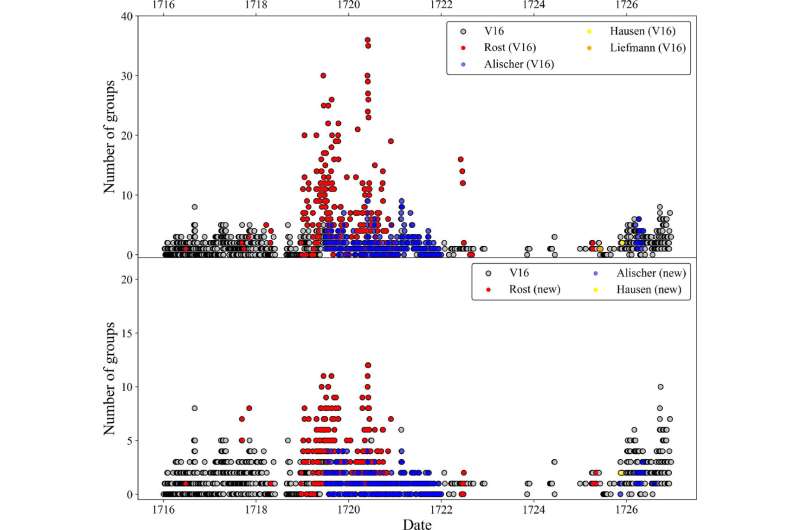August 20, 2024 feature
This article has been reviewed according to Science X's editorial process and policies. Editors have highlighted the following attributes while ensuring the content's credibility:
fact-checked
peer-reviewed publication
trusted source
proofread
Corrected sunspot records show the Maunder minimum did not end abruptly

How accurate are past records of sunspots? In a new study published in The Astrophysical Journal, a team of multinational researchers examined the historical record and found that after the unusual period of almost no sunspots, a period called the Maunder minimum, the transition to a more normal number of sunspots was not nearly as abrupt as had been thought.
The finding has implications for understanding the solar dynamo, the physical processes in the sun that create its magnetic field, and the sun's influence on Earth.
Solar sunspots, dark spots on the sun's bright surface, are useful to scientists as a proxy for the sun's interior processes and its output. Astronomers began recording sunspot numbers as early as 165 BCE, albeit with gaps in the Middle Ages and the 15th century. Systematic counts of sunspots by telescopes began in the 16th century, and the Solar Influences Data Analysis Center at the Royal Observatory of Belgium has kept a record of the monthly average daily sunspot number since 1749.
Sunspots are useful for predicting space weather, conditions in the ionosphere, the solar dynamo (the physical processes in the sun that generate its magnetic field) and as a proxy for solar output, which in turn determines how much energy in sunlight strikes the top of the Earth's atmosphere, which can influence surface temperatures on Earth and global warming.
One of the most interesting eras in sunspot history was the grand solar minimum called the Maunder minimum, a period from 1645 CE to 1715 that saw a rare dearth of sunspots, in some spans numbering as low as 0.1% of those seen in modern times.
The Maunder minimum was once thought to be linked to the Little Ice Age (LIA), a cool period in some parts of the Northern Hemisphere that occurred from the early 14th century through the mid-19th century, but in recent years, scientists have since found the LIA's cause to be mainly volcanic activity in the 13th century.
Sunspot activity returned to "normal" afterward. Nothing like the Maunder minimum has been seen in the era of telescopes, not even the Dalton minimum from about 1790 to 1830.
"We found that the recovery of solar activity after the Maunder minimum may have been more gradual and less intense than previously thought," said Victor Carrasco, lead author and a research assistant at the Universidad de Extremadura in Badajoz, Spain. "Before our study, it was thought that the transition from the end of the Maunder minimum to the period of 'normal' solar activity was abrupt. This finding has important implications for solar dynamo models."
The group reexamined the data records of sunspot observers from the time, including German astronomers Johann L. Rost and Sebastian Alischer, in the 11-year period 1716 to 1726. Many of these old records have been carried forward in databases by subsequent observers, many of them now online.
In closely examining these records and others, including drawings of the sun's surface by Johann Christoph Müller, they immediately suspected the values recorded by Rost seemed to be muddled. In particular, they believed Rost, who authored the most records, had possibly confused counts of individual sunspots with sunspot group counts.
Sunspot groups are single entities that may include several sunspots close together; they are easier to see, so fewer would be missed. The Rost record also had most sunspots appearing in the sun's southern hemisphere.
Rost had made both textual entries in his records, numbering and listing the sunspots he observed, as well as diagrams that indicated their positions on the sun's disk. Carrying out a new sunspot group counting, the team defined sunspot groups where Rost had described a cluster of sunspots—no easy task as Rost did not always make the distances of each sunspot cluster clear.
They found significant differences. For example, the first solar cycle after the Maunder minimum was found to have a maximum number of sunspot groups of 12, compared to earlier studies. The shape of that cycle became more evident, with a rising phase reaching a maximum number of groups in 1719–1720, then a declining phase to around 1724, followed by a rising phase of the new solar cycle.
They were even able to count a greater number of observation days than Rost and Alischer, as information the two provided was used to determine that sunspots existed even if the exact group number was indeterminate. And they found that hemispheric symmetry had been recovered.
Why do such details matter? "Solar dynamo models incorporate 'intermittencies' in solar activity, meaning that there are periods of strongly suppressed activity that are randomly interspersed with intervals of 'normal' cyclical activity," explained Carrasco. "The Maunder minimum is often cited as an example of such quiescent periods. Our results change the ideas of how solar activity behaves during these transitions and improve our understanding of its long-term behavior."
The group hopes that this work improves the research of solar modelers, and that others will be similarly motivated to uncover sunspot records not yet included in the databases, especially in the 18th century, when the observational coverage was quite low during some periods.
More information: V. M. S. Carrasco et al, Understanding Solar Activity after the Maunder Minimum: Sunspot Records by Rost and Alischer, The Astrophysical Journal (2024). DOI: 10.3847/1538-4357/ad3fb9
Journal information: Astrophysical Journal
© 2024 Science X Network



















